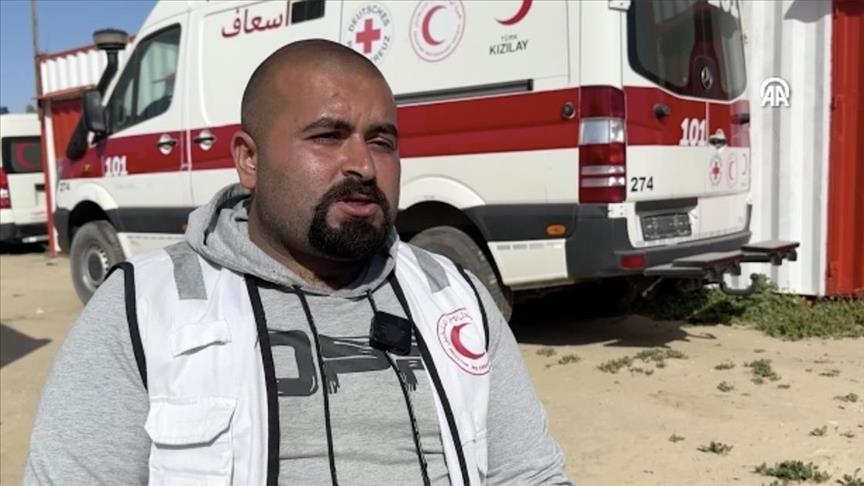INTERVIEW - Survivor of Rafah ambulance massacre exposes Israeli army atrocities
Monther Abed, a paramedic, recounts horrific Israeli attack on his team in Rafah, which killed 15 emergency workers, as new evidence forces Israel to acknowledge crime

GAZA CITY, Palestine
A volunteer paramedic with the Palestinian Red Crescent will never forget the Israeli military's atrocity when they targeted him and his colleagues in Rafah, southern Gaza, on March 23.
In the massacre, Israeli forces killed 15 emergency and civil defense workers, who were protected by international law, marking another chapter in Israel's ongoing genocide against Palestinians.
Monther Abed, the sole survivor, recalled the attack in an interview with Anadolu as his team responded to distress calls from civilians trapped by Israeli forces in the Tel al-Sultan neighborhood of Rafah.
The team, comprising 10 paramedics, five civil defense members, and a UN staffer, rushed to the location, hoping to save lives.
Heavy gunfire
“We received a signal about injuries in the Hashashin area in Tel al-Sultan, and we immediately moved to assist,” Abed, in his 30s, told Anadolu. “Our ambulances, marked with the Palestinian Red Crescent’s insignia, had their lights on, both inside and out.”
Upon arrival, they were met with heavy and direct gunfire. Abed described diving into the back of the ambulance for cover, hearing nothing from his colleagues except their final breaths.
Shortly after, an Israeli special forces unit arrived, opened the vehicle's door and spoke in Hebrew. They forced Abed to the ground to shield him from seeing the fate of his colleagues.
Severe torture
After the gunfire hit the ambulances, Israeli soldiers pulled Abed from the wreckage, blindfolded him, and detained him for 15 hours of intense interrogation.
“They beat me with the butts of rifles, tortured me, and repeatedly asked for my name, address, and details about my whereabouts on Oct. 7, 2023,” Abed recounted. “The more I answered, the harder they beat me. I wished for death from the pain.”
Abed revealed that Israeli forces used bulldozers to dig several pits at the site, burying the ambulances and civil defense vehicles with their crews inside after opening fire on them.
On March 27 and 30, Gaza authorities announced they had recovered the bodies of the 15 emergency workers, buried about 200 meters (656 feet) from their vehicles.
Preliminary indications showed the victims were shot, and some were found with their hands bound. This led to growing international condemnation of Israel.
Israeli lies and retraction
On March 31, the Israeli military claimed its forces did not target the ambulances “randomly” but fired at vehicles approaching in a suspicious manner without emergency lights. They also claimed the attack resulted in the deaths of al-Qassam Brigades fighters and eight others affiliated with the Palestinian group Hamas and Islamic Jihad movements.
However, Abed vehemently denied these claims, emphasizing that the area was a civilian zone, not a military operation zone.
He called the attack “a crime against humanity” and accused Israel of trying to cover it up by burying the evidence along with the bodies of the humanitarian team.
Final breaths
“I could hear the last breaths of my colleagues,” Abed said. “It was night, and my face was on the ground. I didn’t see them, but I heard their final moments.”
On the evening of March 31, under the pressure of shocking video evidence, the Israeli military reversed its position and admitted to killing the emergency workers in Rafah.
The video, captured by a paramedic on his cell phone before his death, was found with the bodies of the 15 relief workers buried in a mass grave in Tel al-Sultan.
The New York Times reported that the video, obtained from a senior UN diplomat who requested anonymity, showed the ambulances and fire trucks clearly marked, with their emergency lights on, when Israeli forces opened fire.
In light of this evidence, Israel retracted its earlier claims and said a preliminary investigation concluded that the emergency crews approached a Hamas vehicle in Tel al-Sultan, which led soldiers to believe they posed a threat, prompting them to open fire.
Israeli forces denied that the 15 killed aid workers were executed after being bound, as suggested by the video evidence, according to the Israeli daily Haaretz.
They claimed that six of the victims were affiliated with Hamas and that a military bulldozer buried the bodies and vehicles in sand due to “ongoing fighting.”
Despite claims that the bodies were not harmed, Haaretz reported that the video documenting the digging of the mass grave showed the bodies in a deteriorated state, with some disfigured.
Israeli Chief of Staff Eyal Zamir directed the investigation to the army’s military advocate general, which handles cases of potential war crimes. However, Haaretz noted that, despite many reports since the start of the war, no soldiers had been prosecuted for war crimes.
More than 50,700 Palestinians have been killed in Gaza in a brutal Israeli onslaught since October 2023, most of them women and children.
The International Criminal Court issued arrest warrants last November for Netanyahu and his former Defense Minister Yoav Gallant for war crimes and crimes against humanity in Gaza.
Israel also faces a genocide case at the International Court of Justice for its war on the enclave.
Anadolu Agency website contains only a portion of the news stories offered to subscribers in the AA News Broadcasting System (HAS), and in summarized form. Please contact us for subscription options.







